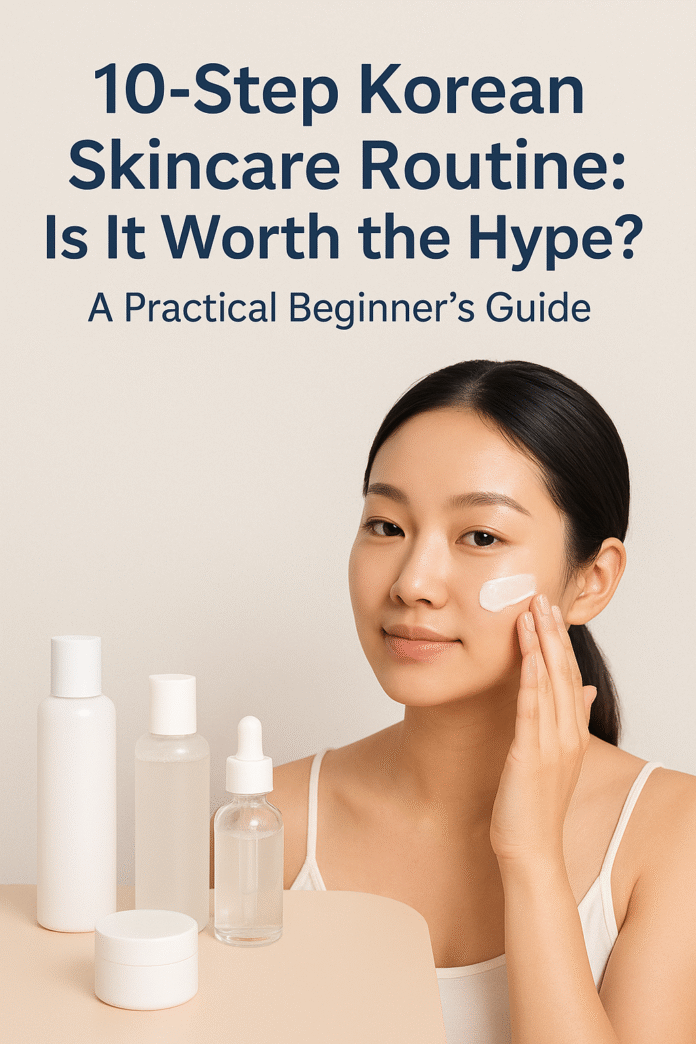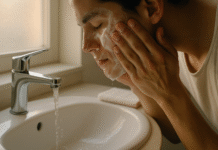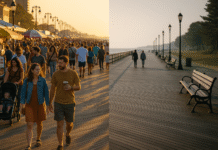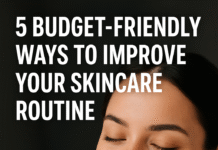The 10-step Korean skincare routine has become a cultural shorthand for meticulous self-care, commitment to hydration, and the pursuit of that luminous “glass skin” finish. If you’re reading this, you’ve probably seen the routine in social posts, beauty websites, or on a shelf at a local cosmetics shop — and you’re asking the right question: what is it, how does it work, and is it actually worth the time, money, and shelf space? This article breaks down the full routine, step by step, explains the science behind the most popular ingredients, lays out realistic beginner-friendly plans, and helps you decide whether to embrace, simplify, or skip parts of it.
Medical disclaimer: this article offers general skincare guidance and summaries of available evidence. It does not replace personalized medical advice. If you have a known skin condition (acne that requires prescription therapy, eczema, rosacea, recent procedures, or immunosuppression), consult a dermatologist before starting new active treatments.
Key takeaways
- The routine is a framework, not a rulebook. The “10 steps” were popularized for western audiences and can be condensed depending on skin type, budget, and goals.
- Cleansing and sun protection are the highest-impact steps. Double cleansing helps remove makeup and sunscreen; daily broad-spectrum SPF is essential.
- Active ingredients (AHAs/BHAs, retinoids, niacinamide, hyaluronic acid) work — but need smart layering and sun protection. Overuse or mixing incompatible actives causes irritation.
- Customization beats strict ritual. Pick steps that address your principal concerns (hydration, acne, pigmentation, sensitivity) and simplify the rest.
- A practical 4-week starter routine can show early improvements in hydration and texture; measurable changes from actives often take 6–12 weeks.
What is the “10-step” routine and where did it come from?
The phrase “10-step Korean skincare routine” describes a multi-product, layered approach that emphasizes gentle cleansing, progressive hydration, targeted serums, and sun protection. In practice, the number of steps can vary and many people in Korea do not follow a strict ten-step regimen every day — the concept became widely known through Western media and retailers that presented a standardized list of product categories to help newcomers navigate K-Beauty innovations.
Why it caught on: the routine reframes skincare as prevention and ritual (rather than episodic problem-fixing), and it popularized product forms that were less familiar in the West at the time — essences, lightweight ampoules, sheet masks, and gentle chemical exfoliants.
Is it a marketing gimmick? Partly. The tidy “10” label simplified and sold an idea that was already evolving in Korea. But the underlying principles — removing impurities, preserving the skin barrier, layering light hydrating textures, and using targeted actives — remain sound when adapted intelligently.
How to read this guide
Below you’ll find one H2 section for each of the classic ten product types. For each step I cover:
- What it is and why it helps,
- What you need and low-cost alternatives,
- Beginner-friendly step-by-step instructions,
- How to scale down or up,
- Recommended frequency,
- Safety notes and common mistakes, and
- A 2–3 step mini-plan example.
After the ten steps there are practical sections: a quick-start checklist, troubleshooting, measuring progress, and a 4-week starter roadmap. Finish with 10 FAQs and a motivating conclusion.
Step 1 — Oil-based cleanser (Cleansing balm/oil)
What it is and core benefits
An oil-based cleanser (balm, cleansing oil) dissolves oil-soluble impurities like sebum, waterproof makeup, and many sunscreens without requiring harsh scrubbing. It’s the first part of the popular “double cleanse” method.
Requirements / prerequisites / cost
- What you need: an oil or balm cleanser (price range wide: low-cost drugstore to premium K-Beauty).
- Low-cost alternative: gentle micellar cleansing oil or a small amount of pure, non-comedogenic oil (e.g., fractionated coconut oil or sunflower oil) used briefly and rinsed. Avoid using cooking oils that are comedogenic or fragranced.
Step-by-step (beginner)
- Warm a small amount in your palms.
- Massage gently across dry skin for 30–60 seconds to dissolve makeup/sunscreen.
- Emulsify with a little lukewarm water, continue massaging, and rinse well (or wipe off with a damp, soft cloth).
- Follow immediately with a water-based cleanser.
Beginner modifications and progressions
- Simplify: If you rarely wear makeup or sunscreen, you can skip the oil step some mornings.
- Scale up: If you use heavy waterproof mascara or long-wear sunscreen, invest in a higher-quality cleansing balm and a soft muslin cloth for removal.
Frequency / duration
Daily in the evening when removing makeup and sunscreen. Optional in the morning if your skin tolerates it and you prefer extra cleansing.
Safety / caveats / common mistakes
- Over-massaging or rough cloths can irritate; keep movements gentle.
- Some cheap oils can clog pores for acne-prone skin — patch test.
Mini-plan (2 steps)
- PM: Oil cleanse → gentle water-based cleanse.
Step 2 — Water-based cleanser (Foam, gel, cream)
What it is and core benefits
A water-based cleanser removes water-soluble impurities (sweat, leftover oil residue) and completes the cleansing process, helping skin be receptive to subsequent hydrators and actives. Use a formula matched to your skin type (gel for oily, cream for dry).
Requirements / prerequisites / cost
- What you need: gentle, pH-balanced cleanser.
- Low-cost alternative: gentle soap-free cleansers from pharmacy brands.
Step-by-step
- With damp hands, apply a pea-sized amount.
- Massage for 20–30 seconds.
- Rinse with lukewarm water and pat dry gently.
Beginner modifications and progressions
- Simplify: Use only the water-based cleanser twice daily if you never wear sunscreen or makeup.
- Progress: Add a cleanser with mild actives (like niacinamide or low-percent BHA) if acne is a concern — but introduce slowly.
Frequency / duration
Twice daily for most skin types; once daily (PM only) may suit very dry or sensitive skin.
Safety / caveats / common mistakes
- Avoid high-foaming, striping cleansers for dry or barrier-compromised skin.
- Hot water increases irritation — use lukewarm.
Mini-plan (2 steps)
- AM: Water-based cleanse → moisturizer.
- PM: Oil cleanse → water-based cleanse.
Step 3 — Exfoliation (Chemical or physical)
What it is and core benefits
Exfoliation removes dead surface cells to improve texture, unclog pores, and help active ingredients penetrate. Chemical exfoliants (AHAs like glycolic/lactic acid; BHAs like salicylic acid) are generally preferred for controlled, even results. Evidence supports AHAs and BHAs for improving texture, acne, and pigmentation when used correctly.
Requirements / prerequisites / cost
- What you need: a low-to-moderate concentration product (e.g., 5–10% AHA, 0.5–2% BHA) or periodic peel masks.
- Low-cost alternative: BHAs at low concentration are widely available in drugstores; fruit-acid toners can be affordable but watch pH.
Step-by-step
- Start with a patch test.
- Begin with once-weekly application at low concentration.
- If tolerated, increase to 2–3 times per week.
- Always apply sunscreen during the day when using AHAs/BHAs — chemical exfoliants increase sun sensitivity.
Beginner modifications and progressions
- Simplify: Use a wash-off exfoliating cleanser once a week.
- Progress: Move to leave-on toners/serums with low concentrations and gradual frequency increases.
Frequency / duration
1–3 times weekly depending on concentration and skin tolerance. Stronger professional peels are less frequent and should be performed by a professional.
Safety / caveats / common mistakes
- Over-exfoliation causes redness, barrier damage, and sensitivity.
- Don’t mix strong retinoids and high-concentration acids at the same time of day without guidance.
- Apply daily sunscreen after exfoliating.
Mini-plan (2 steps)
- Week 1–2: Water-based cleanse → gentle AHA/BHA toner once weekly → moisturizer.
- Week 3–4: If tolerated, increase to twice-weekly.
Step 4 — Toner (hydrating or pH balancing)
What it is and core benefits
Modern toners are mostly hydrating or functional (contain humectants, soothing botanicals, or low-strength actives) rather than the harsh alcohol-based toners of the past. They help restore hydration and, in some formulations, prepare the skin for serums.
Requirements / prerequisites / cost
- What you need: a lightweight hydrating toner (look for glycerin, hyaluronic acid, or mild soothing ingredients).
- Low-cost alternative: a simple humectant-rich toner or diluted glycerin mix.
Step-by-step
- Apply to a cotton pad or your palms.
- Pat onto the face while skin is slightly damp to lock in moisture.
Beginner modifications and progressions
- Simplify: Skip if you don’t like extra layers — this step is optional.
- Progress: Use functional toners that include low-dose actives (like PHA or low AHA) once you understand your tolerance.
Frequency / duration
Daily, morning and evening if desired.
Safety / caveats / common mistakes
- Avoid alcohol-heavy toners if you have dry or sensitive skin.
- Don’t layer acid toners immediately after other strong actives.
Mini-plan (2 steps)
- Toner (pat-on) → hyaluronic acid serum (next step).
Step 5 — Essence
What it is and core benefits
An essence is a lightweight, highly hydrating, often slightly viscous product that provides an initial boost of hydration and primes skin for subsequent serums. Think of it as “hydration glue” that helps lightweight actives distribute evenly.
Requirements / prerequisites / cost
- What you need: an essence with humectants (hyaluronic acid, glycerin) and low-irritant additives.
- Low-cost alternative: a watery hydrating serum used as an essence.
Step-by-step
- Pour a small amount into palms or a cotton pad.
- Press gently into the skin until absorbed.
Beginner modifications and progressions
- Simplify: If you already use a hydrating serum, you can skip the essence.
- Progress: Use essences with added fermented extracts or low-dose brighteners if tolerated.
Frequency / duration
Daily, AM and PM as desired.
Safety / caveats / common mistakes
- Some essences include fragrances or botanicals that can irritate reactive skin. Patch-test new formulas.
Mini-plan (2 steps)
- Toner (optional) → essence → serum.
Step 6 — Ampoule / Serum (targeted actives)
What it is and core benefits
Serums/ampoules are concentrated treatments that target specific concerns: vitamin C for brightening, niacinamide for barrier and tone, retinoids for cell turnover, peptides for firming, etc. These are the “workhorses” of the routine. Evidence supports the efficacy of many of these ingredients when used correctly (for example, niacinamide improves barrier function and pigments; retinoids help cellular turnover and acne).
Requirements / prerequisites / cost
- What you need: choose one or two active serums targeted to your main concern.
- Low-cost alternative: look for lower-priced serums with clinically supported actives at effective concentrations (e.g., 2–5% niacinamide).
Step-by-step (beginner)
- Start with one active at a time.
- Apply a few drops, pat in gently.
- If using vitamin C, apply in the morning under sunscreen (some forms are light-sensitive). Retinoids are PM only.
Beginner modifications and progressions
- Simplify: Limit to one targeted serum (e.g., niacinamide for pore control or hyaluronic for hydration).
- Progress: Add actives sequentially after monitoring tolerance for 2–4 weeks.
Frequency / duration
Most serums are daily, but potency matters. Retinoids may start every other night.
Safety / caveats / common mistakes
- Mixing vitamin C and niacinamide used to be discouraged but modern evidence suggests common formulations are often compatible; still, patch test.
- Avoid layering multiple potent actives (e.g., high-dose AHA + retinoid) without spacing or professional advice.
Mini-plan (2 steps)
- AM: Hyaluronic essence → antioxidant vitamin C serum → sunscreen.
- PM: Retinoid (every other night) → moisturizer.
Step 7 — Sheet mask / rinse-off mask / treatment
What it is and core benefits
Masks are periodic treatments for hydration, calming, brightening, or exfoliation. Sheet masks deliver a concentrated dose of humectants and actives and are especially popular in K-Beauty for quick, visible hydration boosts. Masks can be used as an occasional intensive treatment.
Requirements / prerequisites / cost
- What you need: masks appropriate for your skin type.
- Low-cost alternative: a thick layer of your moisturizer as an overnight occlusive (or a DIY honey mask for occasional use).
Step-by-step
- Use 1–3 times weekly or as needed.
- Apply to clean skin after serums (or as directed).
- Remove in 10–20 minutes and pat in remaining essence.
Beginner modifications and progressions
- Simplify: Skip if you have budget/eco concerns; use a cream mask weekly instead.
- Progress: Use masks targeted for specific issues (salicylic acid masks for breakouts, enzymatic peels for texture).
Frequency / duration
1–3 times weekly depending on mask strength.
Safety / caveats / common mistakes
- Don’t use exfoliating masks the same day as other strong exfoliants or retinoids.
- Single-use sheet masks are convenient but generate waste; choose rinse-off or reusable options if sustainability matters.
Mini-plan (2 steps)
- PM once weekly: Cleanse → sheet mask for 15 minutes → moisturizer.
Step 8 — Eye cream
What it is and core benefits
Eye creams target the delicate periorbital area with hydration and actives formulated at gentler concentrations (peptides, caffeine for puffiness, low-dose retinoids for fine lines).
Requirements / prerequisites / cost
- What you need: a gentle eye product.
- Low-cost alternative: use a small amount of your regular moisturizer if it’s non-irritating.
Step-by-step
- Use ring finger to gently pat a rice-grain-sized amount around the orbital bone.
- Avoid applying too close to the lash line.
Beginner modifications and progressions
- Simplify: Prioritize face moisturizer and sunscreen; eye cream is optional.
- Progress: If creping or dark circles are a concern, consider targeted actives after dermatology consult.
Frequency / duration
Daily AM and PM as tolerated.
Safety / caveats / common mistakes
- Avoid strong retinoids in eye creams without guidance — they can irritate.
- Don’t rub vigorously; the skin under the eye is thin.
Mini-plan (2 steps)
- AM: Hydrating eye cream → sunscreen.
- PM: Gentle eye cream → moisturizer.
Step 9 — Moisturizer (emulsion/cream)
What it is and core benefits
Moisturizer seals hydration, supports barrier repair, and prevents transepidermal water loss. Choose lighter emulsions for oily skin and richer creams for dry skin. Hydration is the foundation of skin health and helps reduce irritation from actives.
Requirements / prerequisites / cost
- What you need: a moisturizer suited to your skin type (look for ceramides, glycerin, occlusives like dimethicone or squalane).
- Low-cost alternative: petroleum jelly as an occlusive for dry patches; simple glycerin-rich lotions for lighter needs.
Step-by-step
- Apply a dime- to nickel-sized amount.
- Press gently into the face while skin is slightly damp for better absorption.
Beginner modifications and progressions
- Simplify: Use one all-purpose moisturizer for AM and PM.
- Progress: Add a richer night cream or sleeping pack for extra hydration.
Frequency / duration
Daily AM and PM.
Safety / caveats / common mistakes
- Avoid fragranced moisturizers if you have sensitivity.
- Using too little won’t seal in serums properly; using too much can pill under makeup.
Mini-plan (2 steps)
- Essence → moisturizer → (AM) sunscreen.
Step 10 — Sunscreen (AM) or sleeping pack (PM)
What it is and core benefits
AM — Sunscreen: The single most important preventative step for aging, pigmentation control, and skin-cancer risk reduction. High-quality, broad-spectrum SPF applied daily is non-negotiable if you use chemical exfoliants or retinoids. High-quality evidence suggests sunscreen use reduces the development of certain sun-related skin problems.
PM — Sleeping pack: A special occlusive night treatment used in K-Beauty to lock in hydration and deliver actives overnight. Use on nights when you want extra moisture.
Requirements / prerequisites / cost
- What you need: daily broad-spectrum SPF 30 or higher.
- Low-cost alternative: sunscreen sticks or drugstore SPFs are effective — reapply as needed.
Step-by-step (AM sunscreen)
- Apply sunscreen as the final daytime step after moisturizer.
- Use a generous amount (~1/4 to 1/2 teaspoon for the face) and reapply every 2 hours when exposed to sun.
Beginner modifications and progressions
- Simplify: A single effective sunscreen is enough; choose a formula you like to encourage compliance.
- Progress: Layer a physical sunscreen for sensitivity or combine chemical and mineral filters if desired.
Frequency / duration
Sunscreen daily and whenever outdoors; reapply every 2 hours if in direct sun. For sleeping packs, use 1–3 times weekly or nightly as tolerated.
Safety / caveats / common mistakes
- Sunscreen is essential when using exfoliants or retinoids — skipping it increases irritation and photo-damage risk.
- Don’t skimp on amount or reapplication.
Mini-plan (2 steps)
- AM: Moisturizer → broad-spectrum SPF 30+.
- PM: Moisturizer → sleeping pack (optional weekly).
Is the full 10-step routine “worth it”?
Short answer: it depends. The routine is not a magic bullet; it’s a flexible framework that, when used deliberately, supports healthy skin. Here’s how to judge:
- If you want improved hydration and a structured habit: yes, the routine helps many people consistently apply hydrating and protective products, which leads to better-looking skin over time.
- If you prefer minimalism or have sensitive skin: you can prioritize high-impact steps (cleanse, targeted serum, moisturizer, sunscreen) and skip the rest — the benefits will often be comparable for day-to-day health.
- If you love ritual and self-care: the routine has value beyond measurable outcomes; the time and pleasure can improve adherence and mental well-being.
Evidence supports specific components (sunscreen, appropriate chemical exfoliation, niacinamide, hyaluronic acid), but the marginal returns diminish when you add layers for the sake of the number ten. Focus on the right steps for your goals, not the total count.
Quick-start checklist (for a compact, high-impact routine)
AM: gentle water-based cleanse → antioxidant serum (optional) → moisturizer → broad-spectrum SPF 30+.
PM: oil cleanse (if wearing makeup/sunscreen) → water-based cleanse → targeted serum (niacinamide or retinoid on alternating nights) → moisturizer.
Add exfoliation 1–3× weekly and a sheet mask as a treat once weekly.
Troubleshooting & common pitfalls
- Pilling: Caused when serums and creams don’t layer well. Fix: wait 30–60 seconds between layers, apply less product, or change formulation textures.
- Irritation (redness/sting/peel): Stop strong actives, reintroduce one at a time, and prioritize barrier repair (ceramide/moisturizer). Consult a dermatologist for severe reactions.
- Breakouts after adding new oil-based cleanser: Patch-test new oils; substitute with a non-comedogenic formula.
- No visible improvement: Give actives 6–12 weeks to show results; track with photos under consistent lighting.
How to measure progress and results
- Objective markers: hydration (skin feels less tight), texture (fewer bumps/blackheads), reduced pigmentation, and fewer breakouts. Use a weekly photo diary under consistent lighting.
- Timelines: hydration improvements can show in days; texture and pigmentation changes often require 6–12 weeks; retinoid-driven collagen remodeling may take months.
4-Week Starter Plan (Beginner-friendly)
Goal: Hydrate, reduce mild congestion, and establish sunscreen habit.
Week 1
- AM: water cleanse → lightweight moisturizer → SPF 30+.
- PM: oil cleanse if needed → water cleanse → moisturizer.
Week 2
- Add a hydrating essence or hyaluronic acid serum at PM and AM after cleansing. Continue sunscreen daily.
Week 3
- Introduce a gentle BHA (0.5–1% salicylic) once weekly at night to target congestion. Monitor for dryness.
Week 4
- If tolerated, increase BHA to twice weekly. Consider adding a niacinamide serum (2–5%) in the AM or PM based on manufacturer guidance. Track progress with weekly photos.
Product pairing and layering rules (practical guide)
- Thin → thick: water-like products first, creams last.
- Avoid powerful pairs the same time: high-strength AHA + retinoid on the same night increases irritation risk. Space them or alternate nights.
- Sunscreen always last in AM.
- Patch test new actives on inner forearm for 48 hours before full-face use.
Sustainability & cost considerations
The 10-step routine can be expensive and wasteful if you buy single-use masks and dozens of bottles. Tips to save money and reduce waste:
- Pick multipurpose formulations (hydrating serum that doubles as an essence).
- Use reusable muslin cloths for mask removal.
- Buy travel sizes to trial products first.
- Remember: more products does not equal better skin — targeted, evidence-backed products often deliver the most benefit.
10 smart ingredient primers (what to look for and why)
- Hyaluronic acid: hydrates via attraction of water to skin — quick, visible hydration.
- Niacinamide: barrier support, pigment reduction, and oil regulation.
- AHAs (glycolic, lactic): surface exfoliation and glow; increases sun sensitivity.
- BHA (salicylic acid): oil-soluble, penetrates pores — useful for acne-prone skin.
- Vitamin C (ascorbic acid): antioxidant, brightening (stable formulations matter).
- Retinoids: potent for acne and aging; use gradually at night with sunscreen during day.
- Ceramides: essential for barrier repair; often in moisturizers.
- Sunscreen filters: choose broad-spectrum SPF 30+ formulations and reapply.
- Peptides: promising for firmness; evidence is variable.
- Antioxidants: help neutralize free radicals; complementary to sunscreen.
Every ingredient above should be introduced one at a time, and you should track tolerance over several weeks.
Frequently Asked Questions (8–12)
- Do I absolutely need all ten steps?
No. Most people will see the greatest benefits from consistent cleansing, targeted serum (for your main concern), moisturizer, and daily sunscreen. - How long until I see results?
Hydration and smoother texture can appear in days–weeks. Pigmentation and collagen-related changes typically take 6–12+ weeks. - Will more products give faster results?
Not necessarily. Overlapping actives can irritate and set back progress. Smart, consistent use of evidence-backed ingredients wins over piling on products. - Is double cleansing safe for sensitive skin?
Yes, if you choose gentle formulations and avoid harsh scrubbing. Omit the oil step if you find it causes breakouts or irritation. - Can I use AHA/BHA everyday?
It depends on concentration and your tolerance. Many people do better with 1–3 times weekly for stronger formulations and more often only with low concentrations and clinician guidance. - Is sunscreen really necessary every day?
Yes. Daily broad-spectrum sunscreen reduces cumulative sun damage and contributes to reduced risk of some sun-related skin problems. - Are Korean products better than others?
Not inherently. K-Beauty popularized certain formats (essences, sheet masks), but efficacy depends on formulation and active concentrations, not country of origin. - How do I layer vitamin C, niacinamide, retinoids, and acids?
Use vitamin C in the AM (antioxidant), niacinamide is usually well-tolerated AM or PM, acids and retinoids at night (avoid using strong acids and retinoids on the same night). Introduce each slowly. - Can I use a sheet mask every day?
Daily gentle hydrating sheet masks can be fine for many people; avoid daily exfoliating masks. Monitor for irritation. - How should I adapt the routine for oily or acne-prone skin?
Favor lightweight, non-comedogenic formulations; use BHA for pore concerns; avoid heavy occlusives in the AM. - Is the “10-step” approach culturally authentic?
The concept as a rigid ten-step ritual is more of a Western packaging of Korean practices; many people in Korea use multiple products but not necessarily ten steps daily. - When should I see a dermatologist?
For moderate-severe acne, persistent inflammation, sudden pigment changes, or reactions to products, seek professional evaluation.
Final safety reminders and realistic expectations
- Introduce one active at a time and give it several weeks.
- Prioritize barrier repair: ceramides, gentle cleansing, and moisturizer help your skin tolerate actives.
- Sunscreen is non-negotiable when using exfoliants or retinoids.
Conclusion
The 10-step Korean skincare routine is less a rigid prescription and more a useful menu: pick the items that match your skin goals, introduce actives carefully, protect your skin from the sun, and keep hydration at the center of everything. Whether you embrace all ten steps or curate a compact four-step ritual, consistency and informed choices will always outpace gimmicks. Try a focused plan for one month, track results, and scale according to what your skin rewards.
CTA: Ready to try a simple, evidence-backed 4-week routine? Start today: cleanse, hydrate, treat, and protect — then check your progress in 30 days.
References
- Double Cleansing Method Explained: Should You Try It?, Cleveland Clinic, February 2022. . Cleveland Clinic
- The efficacy and safety of sunscreen use for the prevention of skin cancer, Review article, PubMed Central (PMC), 2020. . PMC
- Evaluating the Efficacy and Safety of Alpha-Hydroxy Acids in Dermatological Practice: A Comprehensive Clinical and Legal Review, Review article, PubMed Central (PMC), 2024. . PMC
- Mechanistic Insights into the Multiple Functions of Niacinamide: Therapeutic Implications and Cosmeceutical Applications in Functional Skincare Products, Review, PubMed Central (PMC), 2024. . PMC
- Benefits of topical hyaluronic acid for skin quality and signs of skin aging: From literature review to clinical evidence, Review, PubMed Central (PMC), 2023. . PMC
- A Comprehensive Bibliographic Review Concerning the Efficacy of Organic Acids for Chemical Peels Treating Acne Vulgaris, PubMed Central (PMC), 2024. . PMC
- 10-Step Korean Skincare Routine, Editorial/guide, SokoGlam. (No date provided; cultural/retail overview). . Soko Glam
- The 10 Step Korean Skin Care Routine Is Not Real (And Never Was), Analysis / commentary, The Monodist, 2019. . The Monodist by Odile Monod
- AHA vs BHA: The difference and how to use both, Medical News Today (consumer health article), 2021. . Medical News Today
- Double Cleansing Skin Care Routine: Does It Work?, Healthline (consumer health article), 2023. . Healthline




































